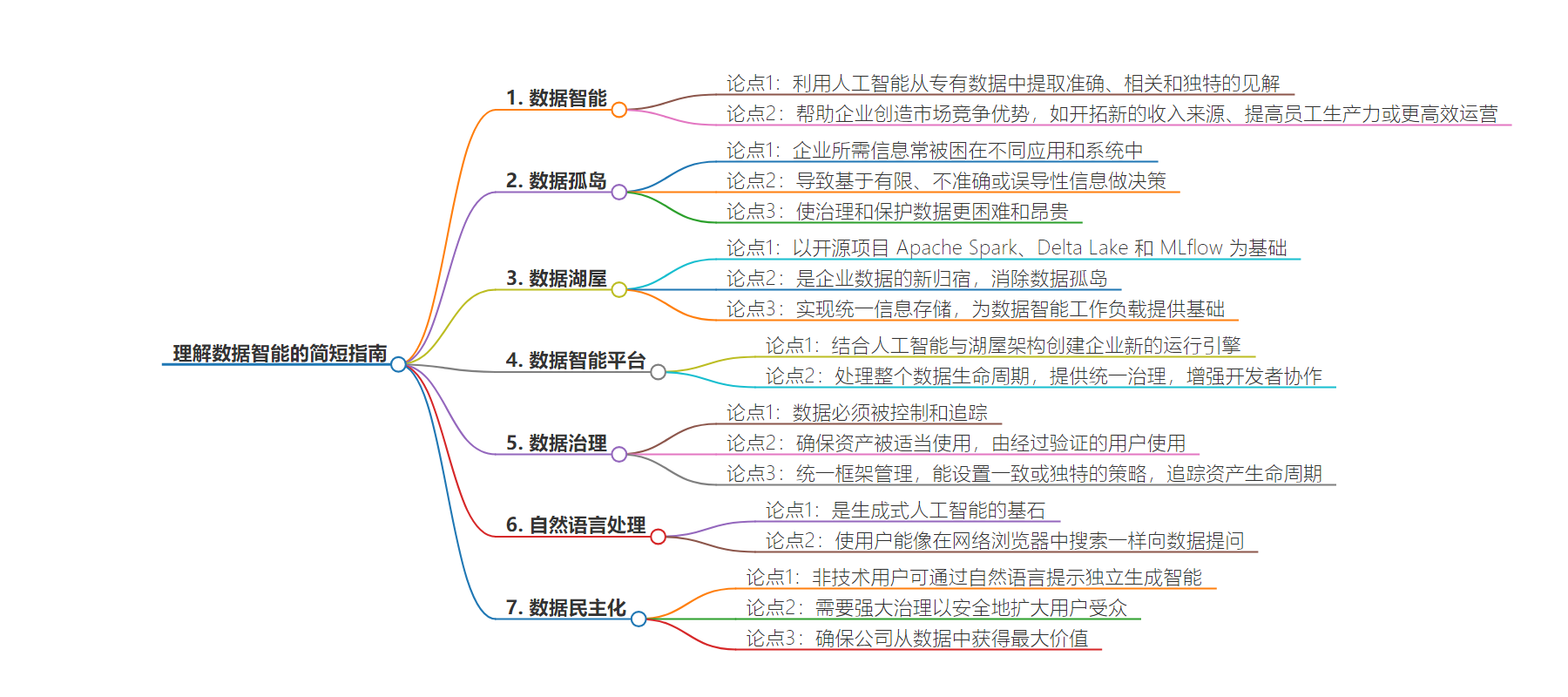包阅导读总结
1. 关键词:Data Intelligence、Data Silos、Data Lakehouse、Data Governance、Natural Language Processing
2. 总结:本文介绍了数据智能相关的概念,包括其含义、作用及关键组成部分,如数据孤岛、数据湖库、治理等,强调理解这些对企业未来运营的重要性。
3. 主要内容:
– Data Intelligence(数据智能)
– 利用 AI 从专有数据中提取准确、相关和独特的见解,帮助企业创造竞争优势。
– Data Silos(数据孤岛)
– 信息被困在企业应用和系统中,导致决策依据有限、不准确或误导,治理和保障数据更困难昂贵。
– Data Lakehouse(数据湖库)
– 以开源项目为支撑,是企业数据的新家,消除数据孤岛,构建统一信息存储。
– Data Intelligence Platform(数据智能平台)
– 结合 AI 与湖库架构,处理整个数据生命周期,提供统一治理,增强协作。
– Data Governance(数据治理)
– 控制和追踪数据,需确保资产被适当使用,不同治理方式可通过框架统一管理。
– Natural language processing(自然语言处理)
– 是 GenAI 的基石,使用户能像在网页搜索一样提问数据。
– Data Democratization(数据民主化)
– 非技术用户通过自然语言提示生成智能,需强大治理保障安全,以最大化数据价值。
思维导图:
文章地址:https://www.databricks.com/blog/short-guide-understanding-data-intelligence
文章来源:databricks.com
作者:Databricks
发布时间:2024/9/1 17:45
语言:英文
总字数:557字
预计阅读时间:3分钟
评分:85分
标签:数据智能,人工智能,数据治理,数据湖与数据仓库融合,自然语言处理
以下为原文内容
本内容来源于用户推荐转载,旨在分享知识与观点,如有侵权请联系删除 联系邮箱 media@ilingban.com
Terms like “data governance,” “Generative AI” and “large language models” are becoming commonplace in the workplace.
But for business leaders, it takes more than just peppering them into conversions and presentations. They must understand what these trends, techniques and technologies actually mean – and the role they’ll play in their organization’s future.
To help, we wanted to define some of the key components of data intelligence, as well as outline for leaders why it’s critical to understand the buzzwords that will ultimately support the next-generation of operations.
Data Intelligence: This is more than information. Data intelligence is using AI to extract accurate, relevant and unique insights from proprietary data. This helps businesses create a competitive advantage in the market, whether that’s identifying new revenue streams, making employees more productive or running more efficiently.
Data silos: The information needed to power data intelligence is often trapped in applications and systems across the business. Without access to a unified set of assets, companies are basing important operating decisions on more limited, potentially inaccurate or misleading information. And critical tasks, like governing and securing the data, become harder and more expensive.
Data Lakehouse: Underpinned by widely adopted open source projects Apache Spark, Delta Lake, and MLflow, a data lakehouse is the new home for enterprise data. Free from closed ecosystems and proprietary format, the architecture eliminates data silos and enables businesses to build unified information stores – spanning structured and unstructured assets – that ultimately serve as a launchpad for data intelligence workloads.
Data Intelligence Platform: The DI Platform combines AI with the lakehouse architecture to create a new operating engine for enterprises. One system handles the whole data lifecycle, from integration through to the development and deployment of analytic and AI workloads, providing unified governance and enhancing collaboration between developers to deliver, and continually improve, dynamic digital solutions that drive business value.
Data Governance: Data must be controlled and tracked. Businesses need to make sure assets are used appropriately, by verified users. Internal teams need to be able to quickly discover data quality issues that could be impacting application performance. But because of the siloed nature of IT environments, there are often many different approaches to data governance. With Databricks’ Unity Catalog, governance is managed through one framework, giving companies the ability to set consistent or unique policies across all their ecosystems, as well as track assets through their lifecycle.
Natural language processing: A cornerstone of GenAI, NLP makes it possible for users to ask questions of data in the same way they would search a web browser. Instead of asking a team of engineers and analysts to compile a report, for example, the CEO will be able to generate the necessary business intelligence with prompts like: “What do my sales look like for the next year?”
Data Democratization: By querying data assets with a natural language prompt, non-technical users can independently generate intelligence, helping to drive better, more informed decision-making. Robust governance is needed to safely broaden the audience of users who can access and use this data. But ultimately, democratization ensures companies maximize the value they get from their data.
For the full introduction to data intelligence, check out Data Intelligence for Dummies, or check out our recent State of Data + AI report to learn more about where businesses are at on their data intelligence journeys.
